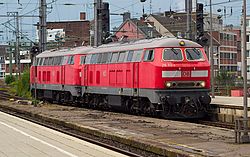
The Deutsche Bundesbahn or DB was formed as the state railway of the newly established Federal Republic of Germany (FRG) on 7 September 1949 as a successor of the Deutsche Reichsbahn-Gesellschaft (DRG). The DB remained the state railway of West Germany until after German reunification, when it was merged with the former East German Deutsche Reichsbahn (DR) to form Deutsche Bahn, which came into existence on 1 January 1994.

Alstom Traxx is a modular product platform of mainline diesel-electric and electric locomotives. It was produced originally by Bombardier Transportation and later Alstom, and was built in both freight and passenger variants. The first version was a dual-voltage AC locomotive built for German railways from the year 2000. Later types included DC versions, as well as quadruple-voltage machines, able to operate on most European electrification schemes: 1.5/3.0 kV DC and 15/25 kV AC. The family was expanded in 2006 to include diesel-powered versions. Elements common to all variants include steel bodyshells, two bogies with two powered axles each, three-phase asynchronous induction motors, cooling exhausts on the roof edges, and wheel disc brakes.

The Prussian state railways' Class P 10 were 2-8-2 "Mikado" type passenger-hauling steam locomotives built for hauling heavy express trains in the hilly terrain of the Mittelgebirge. They were the last Prussian passenger train steam locomotives to be developed in Prussia before the state railways were merged into the Deutsche Reichsbahn, who eventually designated them as DRG Class 39.
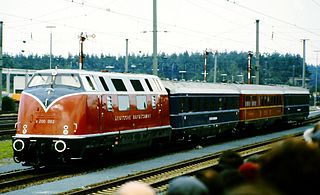
DB Class V 200 was the first series production diesel-hydraulic express locomotive of the German Deutsche Bundesbahn and – as Am 4/4 – of the SBB-CFF-FFS in Switzerland.

The DR Class 243 is a universal electric locomotive of the Deutsche Reichsbahn which is used for general rail service. Deutsche Bahn lists the locomotive as Class 143. The locomotives of class 143/243 still belong to the most successful class of German electric locomotives.

German Kleinlokomotiven like the DRG Kö II were developed as locomotives with a low weight and driving power for light shunting duties. There were two classes, based on engine power. The Class II were engines which developed more than 40 HP.

These DB Class V 100 diesel locomotives were produced in the late 1950s by the Deutsche Bundesbahn for non-electrified branch lines as a replacement for steam locomotives. The V 100 class was built in three different variants.
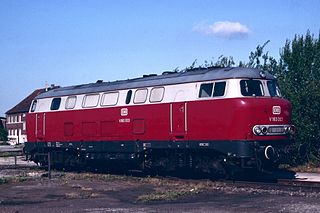
The Class V 160 is a class of diesel-hydraulic locomotives of the German railways. It is the first variant of the V160 family, built for the Deutsche Bundesbahn for medium/heavy trains.
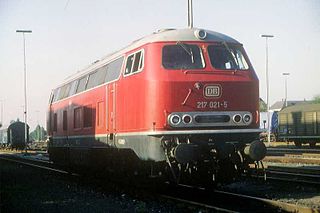
The DB Class V 162 is a class of four-axle diesel hydraulic locomotive built as a development of the DB Class V 160 for the Deutsche Bundesbahn from 1965 to 1968.

The DB Class 215 is a 4 axle diesel locomotive of the V 160 type. They were built for the German Federal Railways for medium-weight passenger and freight service on secondary and primary routes, and later passed to the Deutsche Bahn AG.
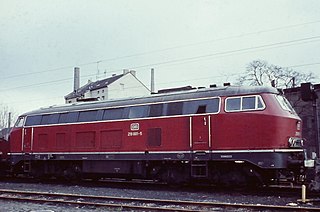
The DB Class V 169 consisted of a single example: V 169 001, derived from the DB Class V 160 family, with an additional gas turbine booster engine. It can be considered the prototype for diesel locomotives with a gas turbine as an additional drive; specifically the DB Class 210. Post 1968 the class designation was changed to Class 219, and the locomotive renumbered 219 001
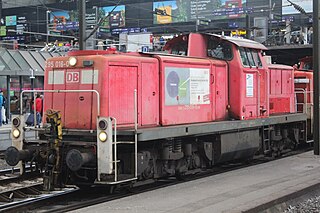
The DB Class V90 locomotive is a German road switcher diesel-hydraulic locomotive for shunting and freight hauling.

Gmeinder GmbH was a German locomotive and engineering company based in Mosbach. Its products included diesel engines, small locomotives (shunters) and other railway locomotive parts. Much of its business came through the German railways, though it also exported to the rest of Europe and the rest of the world.
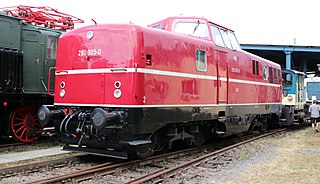
The Class V 80 is a type of German diesel-hydraulic locomotive operated by the Deutsche Bundesbahn, that was redesignated as Class 280 from 1968. It was the first, main line, diesel locomotive with hydraulic power transmission.

The Class 210 of the Deutsche Bundesbahn (DB) consisted, briefly, of a series of eight diesel locomotives, with a top speed of 160 km/h intended for operations on express trains. The locomotives were peculiar in that an additional gas turbine engine was able to provide extra power when needed. The additional turbine made it, at the time, the strongest four-axle German diesel locomotive.

The DR 130 family of locomotives comprises the DR Class 130, DR Class 131, DR Class 132 and DR Class 142, in USSR locomotive called TE109 and TE129.
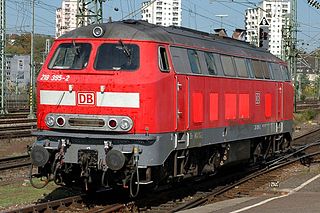
The DB V 160 locomotive family comprises several classes of closely related 4-axle diesel-hydraulic locomotives built in the 1960s and 1970s for the Deutsche Bundesbahn which take the family name from the earliest built model: the 'DB Class V 160'.

The diesel-hydraulic locomotive ML 2200 C'C' was a 6 axle variant of the DB Class V 200 series of locomotives, which were built for Yugoslav State Railways (JDŽ) by manufacturer Krauss-Maffei.

The Stuttgart–Horb railway is a 67.227 kilometer-long railway in the southern part of the state of Baden-Württemberg in Germany, running from Stuttgart to Horb. It forms part of a railway known as the Gäubahn or Gäu Railway. The Royal Württemberg State Railways and the Baden State Railways constructed the majority of this line between the years 1866 and 1879. Today the partially single-track, fully electrified line features the high-speed Intercity-Express (ICE) service, with its tilting train technology, traveling from Stuttgart to Zurich. In addition, a multitude of local train services of numerous railway companies are on offer. The Gäu Railway is also a significant line in the North-South freight service system.
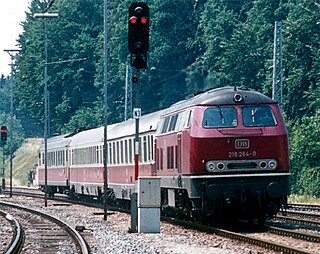
The Buchloe–Lindau railway is a double-track, largely non-electrified main line in the German state of Bavaria. It runs through the Allgäu from Buchloe to Lindau in Lake Constance via Kaufbeuren and Kempten. Together with the connecting Munich–Buchloe railway it is known in German as the Bayerische Allgäubahn.
